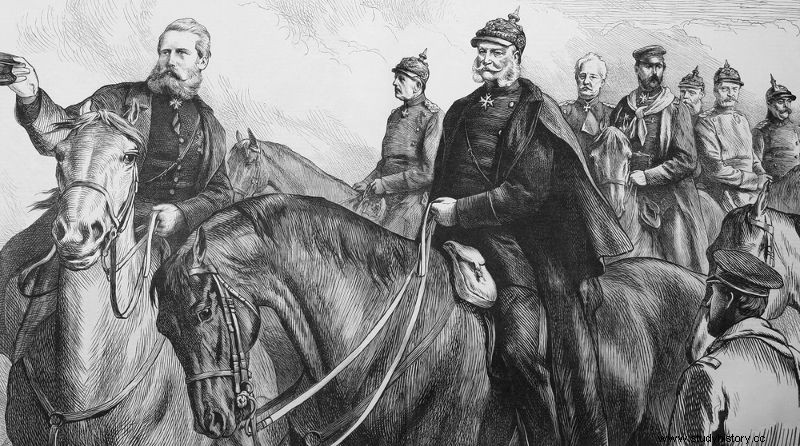
German unification took place in the second half of the 19th century and was responsible for grouping the territory that currently corresponds to the nation-state known as Germany . This process was led by Prussia , the most industrialized kingdom in the region, which, under the leadership of Guilherme I and from Otto von Bismarck , promoted a series of wars to establish the German political and territorial configuration.
Background
At the beginning of the second half of the 19th century, the region of present-day Germany was formed by a series of small kingdoms and duchies, which had been defined as such since the Congress of Vienna and of which many were under the rule of the Austrian Empire (Austro-Hungarian Empire from 1867). These kingdoms had the same cultural base, but they were not unified in the form of a nation-state.
The region had two hegemonic forces:the Kingdom of Prussia , led by the dynasty of the House of Hohenzollern and which was the most economically developed kingdom in the region, and the Austrian Empire , ruled by the Habsburg dynasty and a clearly declining force from the second half of the XIX.
Since the beginning of the 19th century, there has been a strengthening of nationalist ideals in the region that defended the unification of the people of Germanic origin. During the liberal revolutions of 1848 , movements were organized in support of this ideal, however, they failed to achieve this goal.
The project to unify the region was led by Prussia, which saw this plan as a way to guarantee its economic development. Thus, the Prussian leadership in this process began, in fact, with the coronation of William I as King of Prussia and the appointment of Otto von Bismarck as Prime Minister.
In addition to other important names in Prussian management such as Helmuth von Moltke , William I and Otto von Bismarck led a great process of economic development and industrialization of Prussia. They even carried out the modernization of the Prussian army, making it one of the best in all of Europe.
German unification was established after the confrontation of major European nations in three separate conflicts. First there was the War of the Duchies , in which the Prussians faced Denmark. Then came the Austro-Prussian War against the Austrians and, finally, there was the Franco-Prussian War , which consolidated Germanic unification.
Unification Wars
After implementing the Prussian modernization and industrialization project, the Prussian Prime Minister began the conquest of territories from two duchies that belonged to Denmark:Holstein and Schleswig . Prussian ambition over them led to a conflict known as the War of the Duchies .
This conflict was started by Prussia, in partnership with Austria, under the pretext that Denmark had failed to comply with an item of a treaty signed in 1852. In this agreement, Denmark ensured the autonomy policy for the two regions, however, by enacting a new constitution in 1863, the Kingdom of Denmark reduced this autonomy, which was used as a pretext by Prussia to lead the invasion of these duchies in 1864.
The two duchies were quickly conquered by Prussia, and their occupation by Prussia and Austria generated a disagreement between these two nations that led to a new conflict shortly afterwards, in 1866:the Austro-Prussian War . Shortly before this conflict began, Bismarck had acted diplomatically assuring French neutrality.
The Austro-Prussian War was a first major display of military might by the modernized Prussian army. During this war, the Prussians gained the support of the Italians, who were also undergoing their unification process. This was strategically vital to the Prussian victory, as it split the Austrian forces into two fronts, causing them to fight weakened against the Prussians.
With the victory over Austria, Prussia invaded and annexed most of the Germanic duchies that fought on the Austrian side in the war. Furthermore, with this conquest, the Prussians formed the North German Confederation, which excluded Austria and forced the Austrians to pay war indemnity to the Prussians.
The last conflict of German unification was the Franco-Prussian War , which took place between 1870 and 1871, between France and the Kingdom of Prussia. This war was triggered by a disagreement between these two nations over the succession to the Spanish throne. In addition, there was some dispute over control of Germanic kingdoms that had not yet been annexed by the Prussians.
The Franco-Prussian War completely altered the political landscape and part of the European map. The French army, despite some good battles, proved to be obsolete in matters of strategy and armaments during the war and, as a result, suffered a major defeat for the Prussians. This failure cost the French great humiliation as they had to accept vexatious conditions imposed by the Prussians.
The Prussians demanded the possession of Alsace-Lorraine, as well as demanded 5 billion francs in compensation and forced the French to accept a triumphal march of the Prussian army on the city of Paris. With victory and new territories, William I inaugurated the German Empire in 1871 and was crowned kaiser (Emperor).
Consequences
German unification was responsible for changing the balance of power in Europe at the end of the 19th century. The success of this project led by Otto von Bismarck placed Germany as a power and strengthened the imperialist ambitions of the Germans who set out to obtain colonies in Africa.
The humiliation imposed on France, at the end of the Franco-Prussian War, further embittered relations between these two countries and contributed to the development of revanchism, an important factor in the beginning of the First World War. world. Thus, the German imperialist project was put into practice in Europe, since, some time later, in 1914, Germany began the offensive against France.
Take the opportunity to check out our video lesson on the subject:
